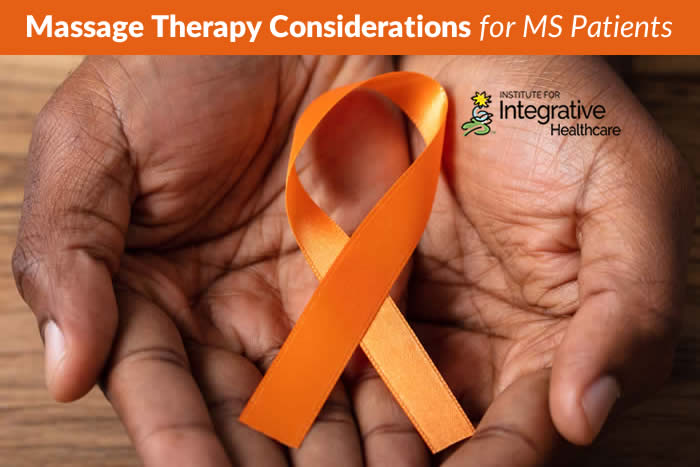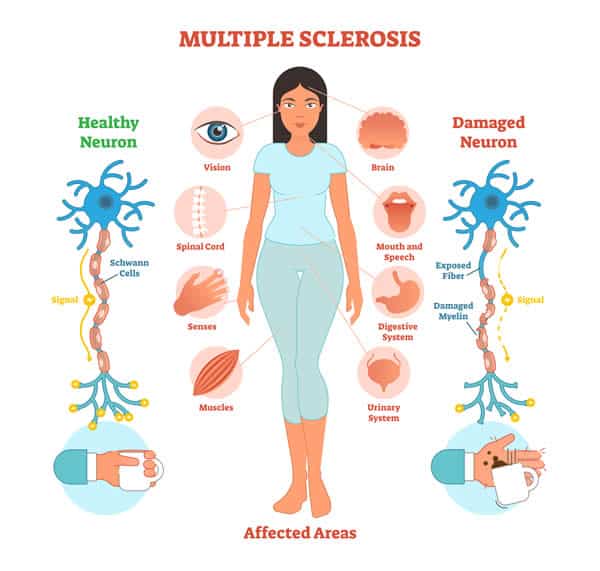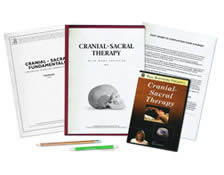

Multiple Sclerosis (MS) is an autoimmune condition presenting inflammation and degeneration of myelin sheath of central nervous system neurons. Myelin is a wrapping around neurons (nerve cells) primarily composed of fat molecules that insulate and protect the neuronal structure and electrochemical messages transmitted through the neuron.
There are four types of Multiple Sclerosis. This list will present this in order of severity, from least to worst in impact upon the nervous system and neuronal anatomy. The term flare-up is used to describe when signs and symptoms appear within the patient. (1)
- Benign MS, also referred to as “clinically isolated syndrome,” involves a client experiencing only one condition episode with no progression.
- Relapsing/Remitting MS is the most common form of MS with signs and symptoms waxing and waning. Full recovery of signs and symptoms is witnessed in the remitting phase.
- Primary Progressive MS features chronic, low grade progression of signs and symptoms with no acute flare-ups.
- Secondary Progressive MS is similar to relapsing/remitting, however no full recovery is witnessed in the remitting phase.
Etiology (Cause)
According to the National Multiple Sclerosis Society, there are numerous factors in the development of MS. These include immunologic factors featuring T and B cell activity; environmental factors such as smoking, obesity and vitamin D acquisition; infectious factors such as the presence of Epstein-Barr virus, Human Herpes virus-6 and/or Chlamydia, pneumonia and genetic factors that suggest the general population has a risk of 1:750-1,000 in acquiring MS. (2)
Epidemiology (Frequency)
According to the MS International Federation, about 2.8 million people worldwide are affected by MS. This figure is double what prior studies revealed. New incidence is mostly witnessed in individuals 20-40 years-old. MS is witnessed more in women than men by a 2-3:1 ratio.
One peculiar item of interest is that MS was once studied as the “cooler climate” condition, as women of European descent were believed to be the highest probable population to acquire MS. However, the Inuit, Australian Aborigines and New Zealand Maoris see nearly zero incident of the condition. (3) This has conjured speculation that dietary factors may be more likely to cause MS than climate.
Classic Signs and Symptoms
There are many classic signs and symptoms of Multiple Sclerosis:
- Blurry vision may be an early sign easily glossed over.
- Optic neuritis may also affect the eyes.
- Muscle spasticity and weakness may result in impaired nerve function.
- Fatigue ranging from moderate to severe may be experienced.
- Gait abnormalities may arise from poor muscle coordination.
- Urologic and sexual dysfunction may be reported.
- Loss of cognitive functions may ensue in advanced cases.

Diagnosis Measures
Multiple Sclerosis is commonly called the “Great Imitator,” as MS is amongst the most misdiagnosed conditions. Many doctors may mistake MS for conditions manifesting in similar manners such as Lyme Disease, Lupus, and Fibromyalgia. (4)
There are four common diagnosis measures to help delineate MS from other similar conditions:
- Blood tests to rule out other conditions with similar signs and symptoms.
- Lumbar puncture to provide sample of cerebrospinal fluid.
- Magnetic Resonance Imagining (MRI) to reveal soft tissue lesions upon brain and spinal cord.
- Evoked potential tests to examine neuromuscular response time and efficiency of nerve conductivity.
Treatments
A common drug category for MS patients is DMAMS (Disease Modifying Agents for MS). Some of the typically prescribed drugs of this category include: Avonex, Extavia, Plegridy, Copaxone and Aubagio. The goals of these drugs are to shorten flare-ups, prolong periods of relapsing and slow immune responses. (5)
Other medications include drugs to control symptoms of fatigue (e.g., Duloxetine, Modafinil), urologic dysfunction (e.g., Detrol, Enablex), cognitive challenges (e.g., Provigil, Exelon), and muscle inefficiency (e.g., Balcofen, Clonodin).
Common side effects of DMAMS include:
- depression
- abdominal discomfort
- rash
- fatigue
- hair loss
- reaction at injection sites
- flu-like symptoms
- and headaches
A massage therapist needs to be conscious of these side effects to modify treatments as necessary. Intensity of treatments can be lessened by altering time, pressure, focal points, pace and media used in session.
A patient’s exercise and diet routine will likely be examined. Physical and/or occupational therapy to restore strength may be employed. Sleep aids may be offered.
Stress management techniques such as massage, meditation, and acupuncture are recommended.
Bodywork Considerations
With classic (Swedish) massage efforts, be aware of pain perception of the client. These can vary daily. There may be injection sites to avoid. A good recommendation is to steer clear at least 3 inches from these sites to avoid site irritation.
Be sure to inquire with the patient about their side effects due to medication use. These can vary per patient and experienced at different levels daily. Abdominal massage can ease tension experienced in the core.
If mobility is becoming a challenge, include passive movement and stretching to keep joints limber. If a therapist has been trained in PNF methods of stretching, these can greatly enhance muscle coordination and efficiency. Thai massage can also incorporate great stretching to patients.
Reschedule sessions during flare-ups when necessary to not aggravate their flare-up. If a patient is in great need of therapeutic touch but cannot receive classic massage therapy, there are bodywork options that may aid in facilitating a parasympathetic response, allowing the client to relax. For example: Cranial sacral therapy, Reflexology and Shiatsu are types of bodywork that aid in this manner.
Testimonial from an MS Patient
Massage therapy can be very impactful for MS patients. Elena, an MS patient and personal client in Tempe, Arizona, wrote of her experience receiving massages.
“I have been fortunate enough to have been going to Jimmy for therapy since 2015. His massage therapy has been instrumental in my success of recovery over quite a few of my severe health issues. While I was diagnosed with cirrhosis, which originally prompted me to seek him out, I also had chronic migraines and chronic neck/back pain for 15 years to this point already. And then in 2018 I was diagnosed with Multiple Sclerosis. I can say with full confidence, I would not be in as good of health as I am today without the aid and massage therapy of Jimmy. Western medicine and doctors failed me but Jimmy listened to me. He has always given me light at the end of my tunnel. I highly recommend a massage to any MS patient.”
Information presented is never intended to replace advice from a medical professional. Please honor requests of the physician and complimentary practitioners in the care of one’s health condition.














